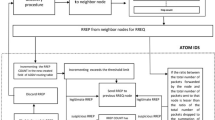Abstract
Mobile Ad-hoc Network (MANETs) is infrastructure less in nature as it is encompassed with a collection of mobile nodes. The self-configurable feature of it has proven to be beneficial in times of disaster relief and rescue operations as the mobile nodes can be effortlessly deployed regardless of the geographical location. In this network, communication take place with the aid of several cooperative routing protocols such as AODV, DSDV, DSR etc., Due to the lack of a centralized administration, the network is prone to copious routing attacks. In this paper, an intrusion detection system called ‘Accurate and Cognitive Intrusion Detection System’ (ACIDS) for detecting the most vulnerable packet dropping attack known as black hole attack has been developed. This system takes the parameters such as Destination Sequence Number (DSN) and Route Reply (RREP) into consideration for detecting the intruders by identifying the deviation of the chosen parameters from the normal behavior. The proposed system has been simulated using NS2 and the analysis of the results attest to the efficacy of ACIDS over AODV routing protocol in detecting packet dropping scenarios of the black hole attack.





Similar content being viewed by others
Explore related subjects
Discover the latest articles, news and stories from top researchers in related subjects.References
IETF Mobile ad-hoc networks working group (MANET), IETF website, www.ietf.org/dyn/wg/charter/manet-charter.html.
Nadeem A, Howarth MP (2013) A survey of MANET intrusion detection & prevention approaches for network layer attacks. IEEE Commun Surv 15(4):2027–2045
Marathe N, Shinde SK (2019) ITCA, an IDS and trust solution collaborated with ACK based approach to mitigate network layer attack on MANET routing. Wirel Pers Commun:1–24
Zhou L, Haas ZJ (1999) Securing ad hoc networks. IEEE Netw 13(6):24–30
Deng H, Li W, Agrawal DP (2002) Routing security in wireless ad hoc networks. IEEE Commun Mag 40(10):70–75
Gurung S, Chauhan S (2019) A survey of black-hole attack mitigation techniques in MANET: merits, drawbacks, and suitability. Wirel Netw:1–31
Kumar S, Dutta K (2016) Intrusion detection in mobile ad hoc networks: techniques, systems, and future challenges. SECUR COMMUN NETW 9(14):2484–2556
Su MY, Chiang KL, Liao WC (2010) Mitigation of black-hole nodes in mobile ad hoc networks. In: International symposium on parallel and distributed processing with applications, pp 162–167. IEEE
Babu MR, Usha G (2016) A novel honey pot based detection and isolation approach (NHBADI) to detect and isolate black hole attacks in MANET. Wirel Pers Commun 90(2):831–845
Tseng FH, Chou LD, Chao HC (2011) A survey of black hole attacks in wireless mobile ad hoc networks. HUM-CENT COMPUT INFO 1(1):4
Madhuri K, Viswanath NK, Gayatri PU (2016) Performance evaluation of AODV under black hole attack in MANET using NS2. In 2016 international conference on ICT in Business Industry & Government (ICTBIG), pp 1–3. IEEE
Gurung S, Chauhan S (2019) Performance analysis of black-hole attack mitigation protocols under gray-hole attacks in MANET. Wirel Netw 25(3):975–988
Dokurer S, Erten YM, Acar CE (2007) Performance analysis of ad-hoc networks under black hole attacks. In: Proceedings 2007 IEEE SoutheastCon, pp 148–153. IEEE
Liu K, Deng J, Varshney PK, Balakrishnan K (2007) An acknowledgment-based approach for the detection of routing misbehavior in MANETs. IEEE Trans Mob Comput 5:536–550
Jayakumar G, Gopinath G (2007) Ad hoc mobile wireless networks routing protocols–a review. J Comput Sci 3(8):574–582
Ad hoc On-Demand Distance Vector (AODV) - Routing protocol https://tools.ietf.org/html/rfc3561
Shakshuki EM, Kang N, Sheltami TR (2012) EAACK—a secure intrusion-detection system for MANETs. IEEE Trans Ind Electron 60(3):1089–1098
Marti S, Giuli TJ, Lai K, Baker M 2000 Mitigating routing misbehavior in mobile ad hoc networks. In: Proceedings of the 6th annual international conference on mobile computing and networking, pp 255–265. ACM
Tseng CY, Balasubramanyam P, Ko C, Limprasittiporn R, Rowe J, Levitt K (2003) A specification-based intrusion detection system for AODV. In: Proceedings of the 1st ACM workshop on security of ad hoc and sensor networks, pp 125–134. ACM
Su MY (2011) Prevention of selective black hole attacks on mobile ad hoc networks through intrusion detection systems. Comput Commun 34(1):107–117
Raj PN, Swadas PB (2009) Dpraodv: a dyanamic learning system against blackhole attack in aodv based manet. arXiv preprint arXiv:0909.2371
The Network Simulator NS-2 version 2.35 http://www.isi.edu/nsnam/ns/index.html
Acknowledgements
Author V.R. Sarma Dhulipala wish to acknowledge the fund received by Department of Science and Technology, Grant No.DST/CERI/MI/SG/2017/080 (AU) (G).
Author information
Authors and Affiliations
Corresponding author
Additional information
Publisher’s note
Springer Nature remains neutral with regard to jurisdictional claims in published maps and institutional affiliations.
Rights and permissions
About this article
Cite this article
Sivanesh, S., Dhulipala, V.R.S. Accurate and Cognitive Intrusion Detection System (ACIDS): a Novel Black Hole Detection Mechanism in Mobile Ad Hoc Networks. Mobile Netw Appl 26, 1696–1704 (2021). https://doi.org/10.1007/s11036-019-01505-2
Published:
Issue Date:
DOI: https://doi.org/10.1007/s11036-019-01505-2




